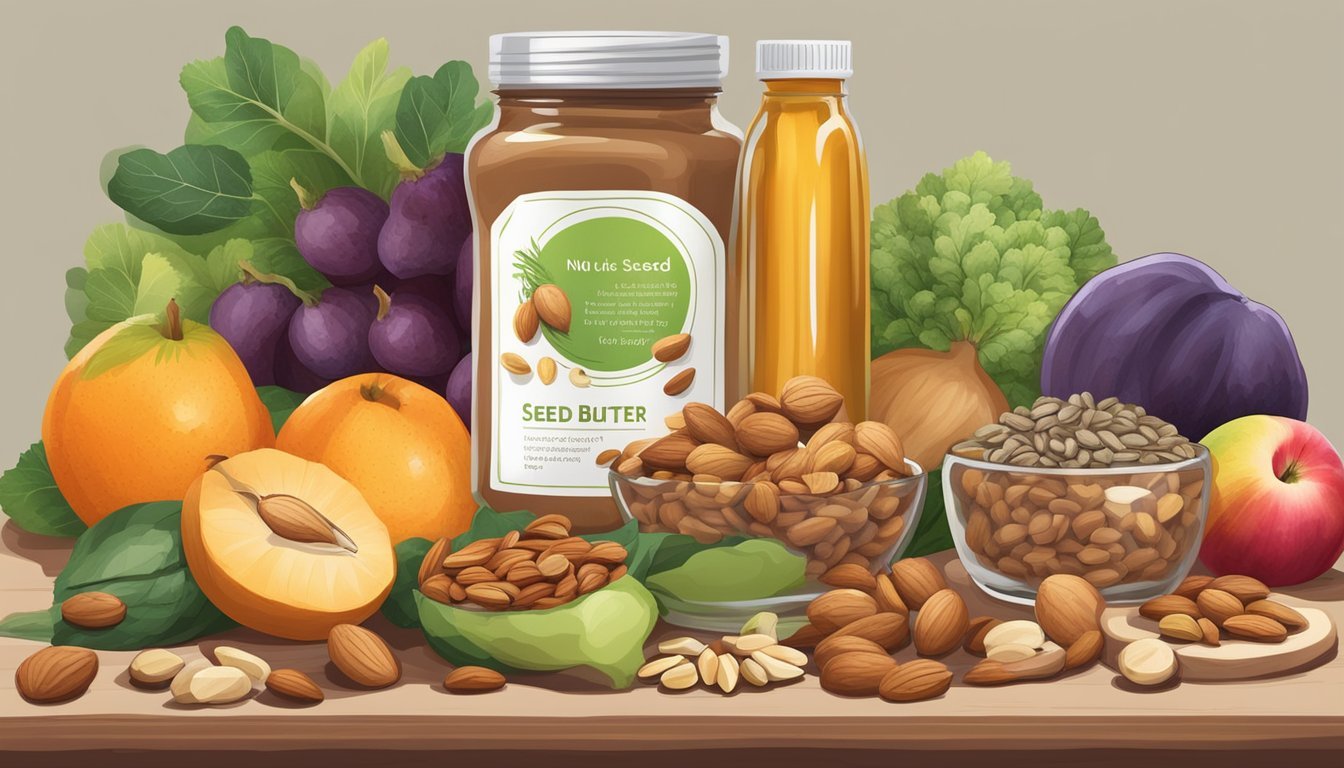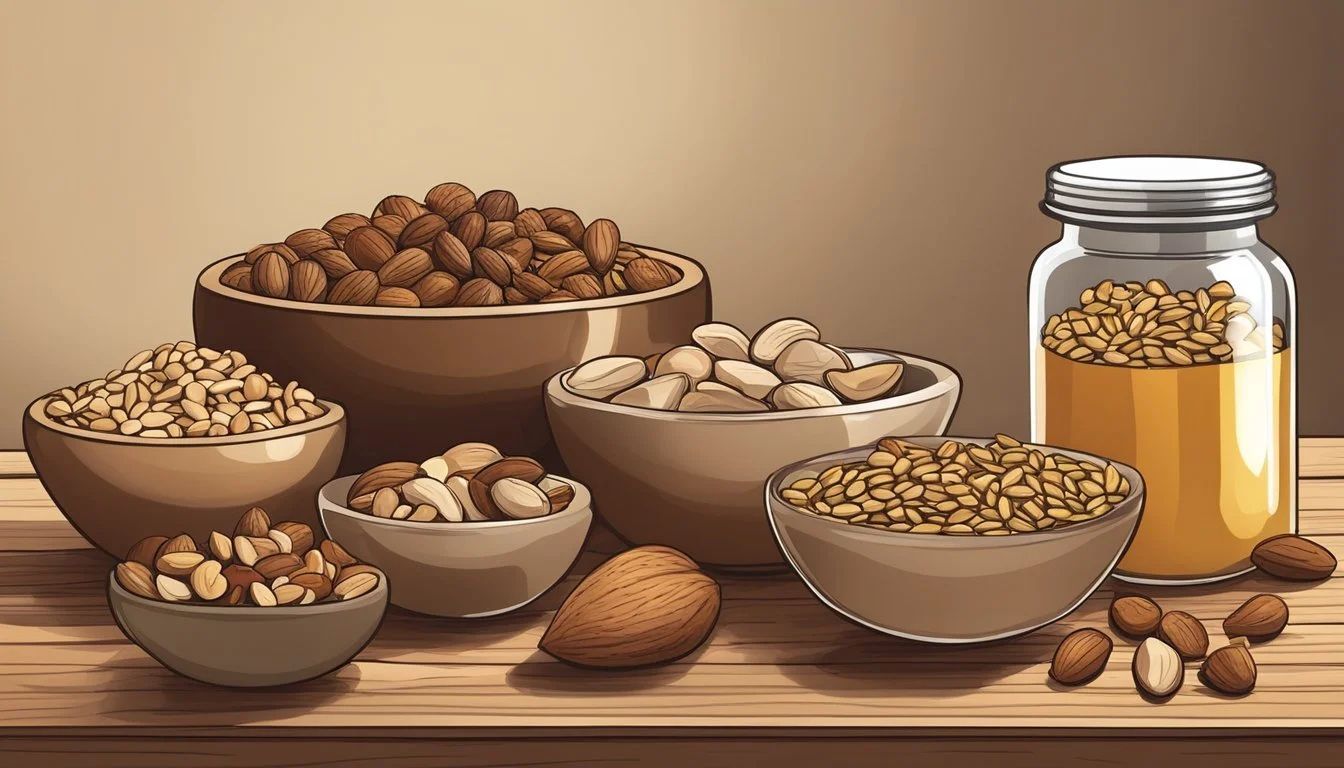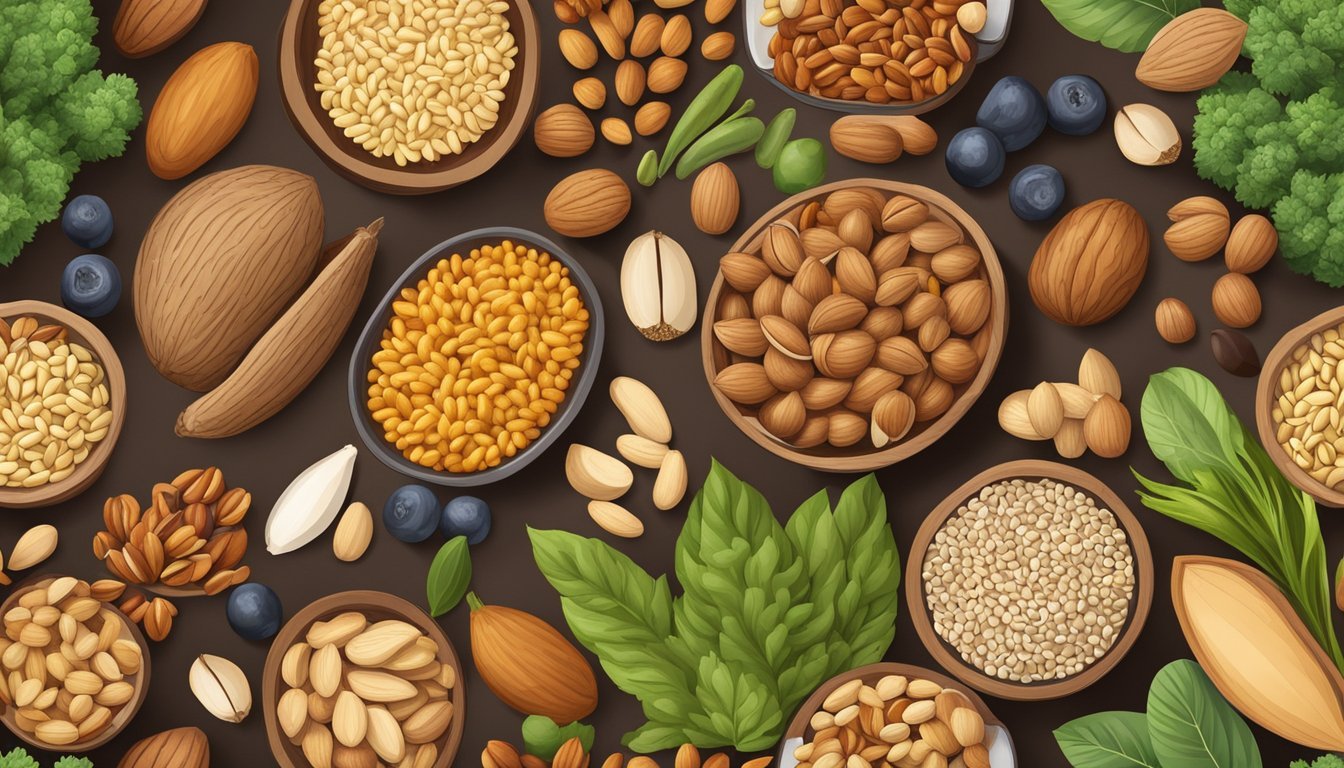High-Fat Diet: How to Incorporate Nuts and Seeds into Healthy Eating Plans
Nut consumption has been linked to a variety of health benefits, including improved heart health and reduced inflammation. Despite their high fat content, nuts (What wine goes well with nuts?) and seeds are considered a vital part of a balanced diet due to their rich nutrient profiles. They are packed with healthy monounsaturated and polyunsaturated fats, which are essential for maintaining good cholesterol levels and providing sustained energy. Additionally, nuts and seeds are an excellent source of fiber, protein, and essential vitamins and minerals such as magnesium, vitamin E, and omega-3 fatty acids.
Incorporating nuts and seeds into the diet can be simple and does not require drastic changes. They can be added to various meals throughout the day to enhance texture, taste, and nutritional value. For instance, a handful of almonds or walnuts can be included in breakfast cereals or mixed into yogurt. Seeds like flaxseeds or chia seeds can be blended into smoothies or sprinkled over salads for an extra boost of nutrients. It's important, however, to be mindful of portion sizes as nuts and seeds are calorie-dense; a small handful, approximately an ounce, is usually the recommended serving size.
While integrating nuts and seeds into one's diet, it's essential to choose raw or dry-roasted varieties without added sugars or salt to maximize health benefits. Pesto made from cashews or pine nuts, for instance, offers a healthier alternative to traditional, cheese-rich versions. Such simple adjustments in daily eating habits can significantly contribute to overall health and well-being.
Understanding Fats and Their Role in Nutrition
To understand the incorporation of nuts and seeds into a high-fat diet, it is critical to grasp the role of fats in nutrition -- their types, health impacts, and how they affect cholesterol levels and heart health.
The Basics of Fats and Dietary Fat
Fats, essential nutrients for the human body, provide energy, support cell growth, protect organs, and help keep the body warm. Dietary fats also aid in the absorption of certain vitamins and produce important hormones. There are primarily two forms of fats: saturated fats and unsaturated fats. Saturated fats typically solidify at room temperature and are found in animal products and certain oils. Unsaturated fats, which generally remain liquid at room temperature, include monounsaturated fats and polyunsaturated fats found in plant-based oils, nuts, and seeds.
Differentiating Healthy Fats from Unhealthy Ones
Not all fats have the same effects on health. Monounsaturated and polyunsaturated fats are known as healthy fats. These fats can support heart health when they replace less healthy fats in the diet. On the other hand, saturated fats and trans fats are viewed as unhealthy. Trans fats, in particular, are associated with an increased risk of coronary heart disease and should be avoided whenever possible. Sources of omega-3 and omega-6 fatty acids, important types of polyunsaturated fats, include fish, walnuts, flax seeds, and certain oils such as sunflower and soybean.
The Impact of Fats on Cholesterol and Heart Health
Cholesterol levels, an indicator of heart health, are influenced by the type of fats consumed. LDL (low-density lipoprotein) cholesterol, known as "bad" cholesterol, can lead to plaque formation in arteries, increasing the risk of cardiovascular disease. Conversely, HDL (high-density lipoprotein) or "good" cholesterol helps remove cholesterol from the bloodstream. Diet high in saturated and trans fats can raise LDL cholesterol levels, whereas unsaturated fats, especially omega-3 fatty acids, have been shown to reduce LDL cholesterol and triglycerides while increasing HDL cholesterol, thus better supporting heart health and potentially lowering the risk of heart disease.
Profile of Nuts and Seeds
In the context of a high-fat diet, nuts and seeds are powerhouses of nutrition, providing a rich supply of healthy fats, protein, and essential micronutrients.
Nutritional Content of Various Nuts and Seeds
Nuts and seeds come packed with a wide array of nutrients that are beneficial for health. They are excellent sources of healthy fats, including both monounsaturated and polyunsaturated fatty acids, which are known to support heart health. The types of fats found in these foods are integral to bodily functions and can aid in the absorption of vitamins.
Nut/Seed Typical Fat Content (per ounce) Protein (per ounce) Fiber (per ounce) Primary Vitamins/Minerals Almonds 14 grams 6 grams 3.5 grams Vitamin E, Magnesium Walnuts 18 grams 4 grams 2 grams Omega-3, Magnesium Chia seeds 9 grams 4 grams 11 grams Omega-3, Iron, Calcium Flax seeds 12 grams 5 grams 8 grams Omega-3, Lignans (antioxidants)
These foods are also an important source of protein, making them an excellent addition to vegetarian and vegan diets. In terms of fiber, nuts and seeds contribute significantly to daily intake, aiding in digestive health.
Health Benefits of Nuts and Seeds
The American Heart Association recommends nuts and seeds as part of a healthy diet due to their beneficial effects on cholesterol levels and heart health. Regular consumption can help reduce LDL cholesterol (the "bad" kind) while improving overall lipid profiles.
They also harbor concentrated amounts of vitamins and minerals such as Vitamin E and magnesium, which play crucial roles in protecting cell integrity and supporting metabolic functions. Almonds, for example, are very high in Vitamin E, which acts as an antioxidant to protect cells from damage.
Omega-3 fatty acids, found notably in walnuts, flax, and chia seeds, contribute to their anti-inflammatory properties. Regular intake of omega-3s can support joint health and has been associated with a lower risk of chronic diseases.
By incorporating a variety of nuts and seeds into one's diet, individuals can take advantage of the synergistic effects of these nutrients. When consumed in moderation and as part of a balanced diet, they can contribute to overall well-being and support the body's health in a multitude of ways.
High-Fat Diet and Weight Management
Managing weight effectively involves understanding the impact of dietary fats, particularly when considering high-fat foods such as nuts and seeds. These sources are calorically dense but offer various benefits for weight management when consumed appropriately.
Caloric Content of High-Fat Foods
High-fat foods are energy-dense, meaning they contain a significant number of calories per serving. For instance:
1 ounce of almonds: Approximately 164 calories and 14 grams of total fat.
1 ounce of walnuts: Around 185 calories with nearly 18.5 grams of fat.
Due to their high caloric content, portion control is paramount when incorporating these foods into a diet.
Incorporating Nuts and Seeds for Weight Management
Nuts and seeds, with their rich content of unsaturated fats, can be integral to weight management diets. Individuals can include a handful of mixed nuts or a sprinkle of seeds to meals, which contributes beneficial fats without excessive calorie intake. Here's how one can add them:
Breakfast: Add flaxseeds to oatmeal or yogurt.
Snack: A small portion of nuts like almonds or cashews.
Dinner: Garnish salads with chia seeds or crushed walnuts.
The key is integrating these items in moderation, as part of a balanced diet.
The Role of Healthy Fats in Satiety and Hunger Control
Healthy fats, particularly unsaturated fats from nuts and seeds, play a crucial role in satiety and controlling hunger. They slow down digestion, which can help individuals feel full longer and potentially reduce overall calorie intake. Additionally, nuts and seeds contain little to no added sugar, making them a suitable option for maintaining stable blood sugar levels.
By focusing on the types of fat consumed — favoring unsaturated fats over saturated and trans fats — individuals can navigate a high-fat diet that supports weight management goals.
Incorporating Nuts and Seeds into Your Diet
Nuts and seeds can significantly enhance the nutritional profile of meals, providing a rich source of omega-3 fatty acids, fiber, and protein. They add energy, flavor, and texture to a variety of dishes.
Practical Tips for Including Nuts and Seeds in Meals
Breakfast: Incorporate seeds, such as chia or flaxseeds, into yogurt or sprinkle onto hot cereals for added fiber and nutrients.
Salads: Enhance salads by adding a handful of nuts like almonds or walnuts, which will contribute both a satisfying crunch and a boost of healthy fats.
Snacks: Swap out less nutritious snacks with a serving of nuts, keeping portions to an ounce or two. Consider options like cashews, pistachios, or seed-based trail mixes.
Lunch and Dinner: Add nuts or seeds to side dishes like brown rice or quinoa for a complete protein source, and use them to adorn cooked vegetables (how long do cooked vegetables last?) or as a garnish on soups.
Creative Ways to Use Nuts and Seeds in Cooking
Nut Butter: Utilize nut butter made from almonds, cashews, or peanuts as a base for sauces or dressings, pairing well with both sweet and savory notes.
Baked Goods: Fold finely chopped nuts into the batter for baked goods such as breads or muffins, contributing to both the taste and nutritional value.
Pesto: Create a nutrient-dense pesto using pine nuts or cashews blended with herbs like basil and nutrient-rich fats such as avocado and olives.
Encrusting Protein: Use crushed nuts as a crust for proteins such as fish or tofu, adding a delectable texture and extra heart-healthy fats.
Incorporating nuts and seeds into one's diet isn't just about adding an ingredient; it's about enhancing the culinary experience while simultaneously boosting nutritional intake.
Risks and Considerations
Incorporating nuts and seeds into a high-fat diet involves assessing potential health risks and nutritional balance. This section outlines the considerations one should keep in mind, such as the prospect of allergic reactions and the management of fat intake, to ensure a positive impact on health.
Potential Allergic Reactions and Intolerances
Nuts and seeds, while nutritious, are common allergens. Reactions can range from mild to severe anaphylaxis. It is essential for individuals who have a known allergy or intolerance to nuts or seeds to carefully read food labels to avoid these ingredients. Moreover, cross-contamination during processing could pose a risk for sensitive individuals, making it critical to source products from trusted brands that cater to allergies.
Balancing Fat Intake to Avoid Negative Health Effects
Fat Composition: A high-fat diet should be carefully balanced, emphasizing healthy fats while limiting harmful ones:
Saturated fat: Found in foods like red meat, butter, and full-fat dairy products, high intake may raise cholesterol levels.
Trans fats: Present in processed foods containing partially hydrogenated oils, these should be avoided due to their link to increased inflammation and heart disease.
Healthy Fats:
Omega-3 fatty acids: Known for anti-inflammatory properties, abundant in seeds like flax and chia.
Omega-6 fatty acids: While also necessary, these should be consumed in moderation as excessive intake can contribute to inflammation.
Experts advise a careful approach to nuts and seeds in the diet; they should serve as supplements, rather than primary sources, of dietary fat. Managing portions is key to avoiding calorie overload and keeping cholesterol in check. Individuals should opt for raw or minimally processed varieties, as these do not contain added salts or fats that could diminish their health benefits.
Nutritional Guidance and Dietary Recommendations
When incorporating nuts and seeds into a high-fat diet, it is essential to understand the types of fats involved and their impact on heart health. The American Heart Association provides guidelines on fat consumption to reduce the risk of heart disease, while the Dietary Guidelines offer broader recommendations on fats with cardiovascular disease prevention in mind.
American Heart Association on Fats and Heart Health
The American Heart Association (AHA) emphasizes the importance of consuming healthy fats, such as those found in nuts and seeds, to support heart health. According to the AHA, individuals should aim for a dietary pattern that includes:
A variety of nuts, seeds, and legumes.
Oils rich in unsaturated fats, such as olive oil.
Fatty fish like salmon, mackerel, and sardines, which are high in omega-3 fatty acids.
This approach is associated with lower cholesterol levels and a reduced risk of cardiovascular disease. The AHA advises minimizing the intake of saturated fats and trans fats, commonly found in baked goods, certain oils, and some dairy products, to further reduce heart disease risk. The goal is to maintain healthy blood pressure levels and cholesterol profiles through a diet rich in unsaturated fats, while avoiding fats that contribute to heart disease.
Dietary Guidelines for Fats and Cardiovascular Disease Prevention
The Dietary Guidelines for Americans provide a framework for healthy eating patterns that include recommendations on fat intake to prevent cardiovascular disease. They propose consuming less than 10% of calories per day from saturated fats, and advise reducing trans fat intake as much as possible.
Key sources for beneficial fats include:
Nuts like almonds, walnuts, and pistachios.
Seeds such as flaxseeds, chia seeds, and hemp seeds.
Fatty fish including tuna, salmon, and mackerel.
Plant-based oils, notably olive oil and those from avocados and olives.
Incorporating these food items into one's diet can help manage cholesterol levels and support overall heart health. It's also suggested to use these healthier fat sources to replace higher saturated fat items, effectively balancing the fat intake to favor heart disease prevention.
Conclusion
Incorporating nuts and seeds into one's diet offers a wealth of health benefits due to their nutrient density. They are packed with healthy fats, such as monounsaturated (MUFAs) and polyunsaturated fatty acids (PUFAs), proteins, fiber, vitamins, and minerals. Incorporating these foods can contribute positively to heart health and overall dietary quality.
The recommended serving size is generally an ounce or two per day to manage caloric intake. Here are ways individuals might include nuts and seeds in their diets:
Sprinkle on salads, yogurts, or whole grains
Blend into smoothies or homemade nut butters
Use them as a crust for meat or fish instead of breadcrumbs
Research indicates that substituting nuts and seeds for less nutritious snacks can be beneficial. Substantial evidence suggests a correlation between regular consumption of these foods and a reduced risk of cardiovascular diseases, when they are part of a diet similar to the Mediterranean eating pattern.
It is important for individuals to exercise portion control and choose unsalted, raw, or dry-roasted varieties to maximize these health benefits. As with any dietary changes, individuals should consult with healthcare providers to ensure that adding nuts and seeds aligns with their personal health goals and dietary needs.




